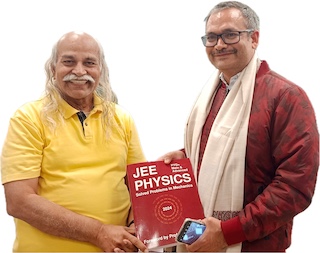Beats
Beats are produced when two progressive waves of slightly different frequencies superpose. Let two waves of same amplitude $A$ but slightly different frequencies $\omega_1$ and $\omega_2 (\approx \omega_1)$ superpose \begin{align} y_1 & =A\sin\omega_1\left(t-\frac{x}{v}\right), \\ y_2 & =A\sin\omega_2\left(t-\frac{x}{v}\right) \end{align} The displacement of the superposed wave is given by \begin{align} y&=y_1+y_2 \\ &=2A\cos\Delta\omega\left(t-\frac{x}{v}\right)\sin\omega\left(t-\frac{x}{v}\right) \end{align} where $\omega=(\omega_1+\omega_2)/2$ and $\Delta\omega=\omega_1-\omega_2 $. The frequency difference $\Delta\omega=\omega_1-\omega_2 $ is called beats frequency. The amplitude varies periodically with the beat frequency. In case of sound, the intensity varies periodically with alternate waxing and waning of sound.
The frequency of a tuning fork decreases when it is loaded with little wax. The frequency increases when prongs are polished (material is removed)
The frequency of a sonometer wire increases when tension is increased.
Problems from IIT JEE
Problem (IIT JEE 2008): A vibrating string of certain length $l$ under a tension $T$ resonates with a mode corresponding to the first overtone (third harmonic) of an air column of length 75 cm inside a tube closed at one end. The string also generates $4$ beats per second when excited along with a tuning fork of frequency $n$. Now when the tension of the string is slightly increased the number of beats reduces to $2$ per second. Assuming the velocity of sound in air to be 340 m/s, the frequency $n$ of the tuning fork (in Hz) is,
- 344
- 336
- 117.3
- 109.3
Solution: The third harmonic in a pipe closed at one end occurs at a frequency, \begin{align} \nu & =3v/(4L) \\ &=3\times 340/(4\times 0.75) \\ &={340}\;\mathrm{Hz}.\nonumber \end{align}
Since string and closed pipe are in resonance, the frequency of string is $\nu={340}\;\mathrm{Hz}$. The tuning fork of frequency $n$ produces 4 beats with the string of frequency $\nu$. Thus, $n-\nu=4$ or $\nu-n=4$ i.e., $n={344}\;\mathrm{Hz}$ or $n={336}\;\mathrm{Hz}$. The frequency of string increases to $\nu^\prime$ with increase in tension $T$ as $\nu\propto \sqrt{T}$. Now tuning fork produces 2 beats. Thus, $n-\nu^\prime=2$ or $\nu^\prime-n=2$. The frequency $n={336}\;\mathrm{Hz}$ gives $\nu^\prime={334}\;\mathrm{Hz}$ or $\nu^\prime={338}\;\mathrm{Hz}$, which is not possible since $\nu^\prime>\nu$. The frequency $n={344}\;\mathrm{Hz}$ gives $\nu^\prime={342}\;\mathrm{Hz}$ or $\nu^\prime={346}\;\mathrm{Hz}$, which is possible.
